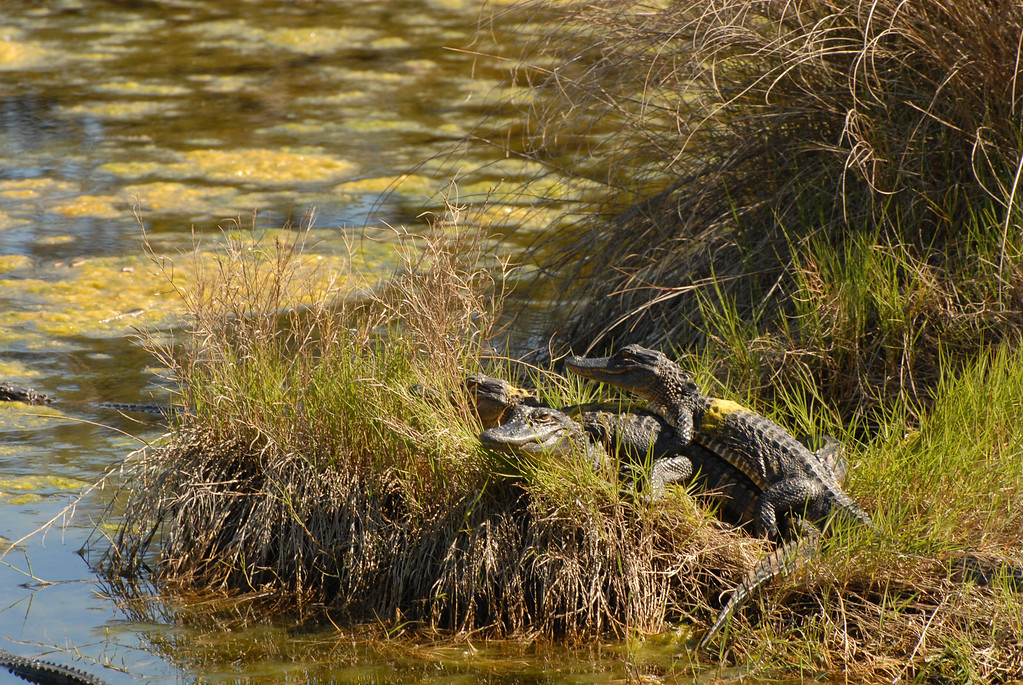Q. I have seen photographs of alligators with herons standing on their backs. This seems like risky behavior. Why would they do that? Do they mistake it for a floating log?
A. I am not aware of anyone testing the following hypotheses with field experiments but here are a few possibilities. This may be a “keep your enemies closer” tactic. I feel certain any wading bird can readily distinguish between a log and an alligator floating in the water and is well aware of where the gator’s mouth is. Standing on the back of the biggest alligator in a wetland would provide a good vantage point for surveying one’s surroundings. The bird could readily escape before the alligator could turn its head around. Further, a close association with the dominant force in the wetland assures no other predator will be a threat. Heron and egret rookeries, where several birds build their nests communally, are frequently located in trees above wetlands where alligators live. In essence the water serves as a moat with armed guards patrolling, which deters raccoons and bobcats from swimming to the trees to grab a snack.
Q. When hiking in the Smokies I often see very large grape vines but no grapes. Are they true grape vines or did long-ago settlers just call them that? Do they produce fruit that I just don’t see? If they aren’t grape vines, what are they?
A. They are probably the leaves of muscadine (aka scuppernong) vines. Muscadines are native to the Southeast and the purple grapes appear in the late summer. However, many vines do not bear grapes, whereas in some years an abundance of grapes might be forthcoming. Another scenario is that wild animals (opossums, raccoons, birds) eat them before you see them. That’s my bet.
Q. I live in the Adirondacks and will be spending quite a few overnights in the woods. Will a timber rattler actively seek out warm objects at night such as a backpacker in a lean-to? Also, it dawned on me that mice might be attracted to a lean-to where food is available from campers. Would a timber rattler be inclined to venture in or near a lean-to in pursuit of mice or a warm body on a cool night?
A. Intriguing questions. Ones for which I can give probabilities but not the 100 percent assurance you would no doubt like to have. The chances of a rattlesnake in the Adirondacks, Appalachians or any other mountains coming into your lean-to because of an attraction to warmth, a mouse meal or simply by chance are very slim. But slim is not impossible.
Timber rattlesnakes get many of their meals as sit-and-wait predators, patiently lying in the same position for hours or even days for a rodent to run down a log or trail. How do snakes know the right spots to coil up and wait? One way is by moving around and picking up chemosensory cues for where squirrels, rats or chipmunks might be. If you had food around, you might attract such rodents. A rattler might chance upon their scents and decide it was a good place to shop for a meal. Long shot, but could happen. The seeking-out-warmth idea would be unlikely because a snake cooling down after dark would probably go into a stump hole or underground right where it was in order to quickly reach a higher temperature than the night air. Again, highly improbable but not completely beyond the realm of possibility for a snake to find itself near your lean-to and decide your sleeping bag makes a satisfactory object to hide under.
However, if I were on the ground in a sleeping bag in the mountains, snakes would not be my first concern. Depending on where you camp, bears might pose a threat. And you are far more likely to share your tent and even your sleeping bag with ticks, redbugs, centipedes and rodents than with a snake.
Send environmental questions to ecoviews@gmail.com.
